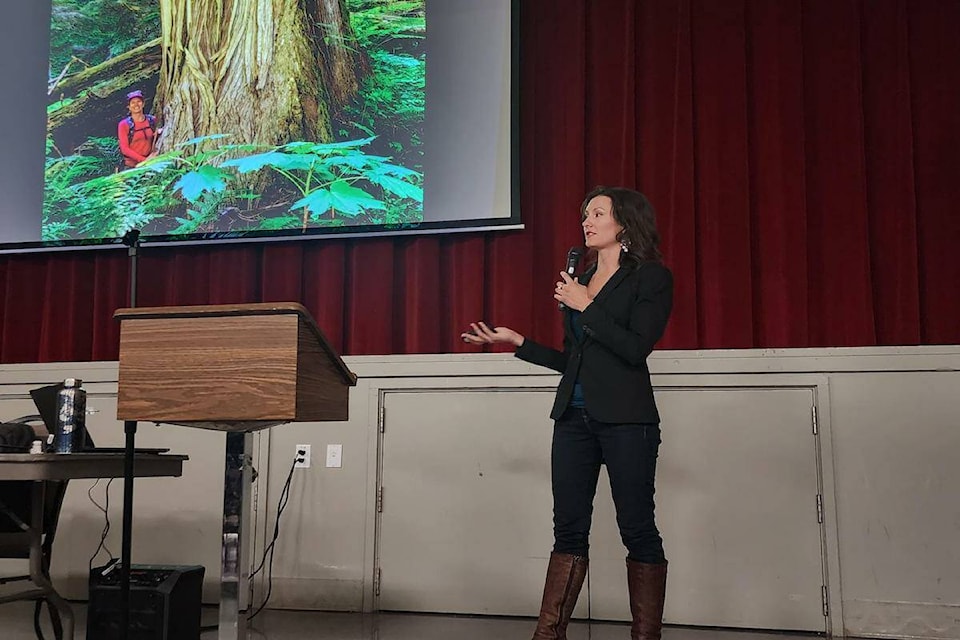Contributed by Kristi Chorney, Wildsight Revelstoke Board Director
The Revelstoke community turned out in full-force recently to learn about the Rainbow-Jordan Wilderness Provincial Class A Park proposal. Amber Peters, Biologist with Valhalla Wilderness Society (VWS) presented the evening of Sept 27th to an estimated 125 people who expressed their appreciation following the presentation with an enthusiastic standing ovation. Wildsight Revelstoke organizers were encouraged by the turn out and large numbers of people who stayed afterwards to pick up letter writing materials to express support to protect this pristine area now and for future generations.
Where is the Rainbow-Jordan Wilderness area?
It’s just north of Revelstoke in the Monashee Mountain Range. It covers an 11,915 hectare stretch of unroaded wilderness with diverse habitats including ancient inland temperate rainforest (ITR) and rare wetland ecosystems.
The Rainbow-Jordan Wilderness includes parts of the Frisby Valley (adjacent to Frisby ridge recreation area), Jordan Valley, and Rainbow Valley. It includes traditional territory of the Sinixt, Ktunaxa, Okanagan, and Secwépemc First Nations.
Why should the Rainbow-Jordan Wilderness be protected?
To retain ecoservices necessary to sustain life on earth such as carbon sequestration (Rainbow-Jordan Wilderness contain some of the greatest carbon sequestering forests in the world), fire break and fire resiliency (as evidence by the forest age and with the wettest forests they are the least likely to burn), provision of clean water, oxygen production, cool & humidify the air and pollination.
To protect intact old growth forest; some of the last of its kind with significant remaining low elevation tracts of ancient Interior Cedar-Hemlock Forest. Three trees are listed with the BC Big Tree Registry. Some trees measure 3.5 metres in diameter and are over 1500 years old.
To enhance biological resiliency given the impending landscape changes that scientists predict will increase with global warming.
To protect this globally significant biodiversity hotspot. Researchers identified 368 species of lichen, plant, and macrofungi during initial surveys and believe they have only scratched the surface of what is to be discovered in this vast wilderness.
To protect critical habitat of substantial size needed for wildlife survival, including recovery of the Deep Snow Mountain Caribou along with at least 185 other known species at risk in BC’s under-protected Inland Rainforest.
To benefit human health and medicine. These ancient remnant ecosystems are libraries of information with huge benefit to human health and medicine, clues to advancement in technology and engineering, and keys to uncovering the secrets of life itself.
For culture. The proposal lies within the area of a traditional village and fishing site of a large band of Sinixt peoples. Much of their cultural heritage has been lost through overdevelopment and resource extraction from similar ecosystems that have since disappeared.
To provide economic value through tourism. The Rainbow-Jordan Wilderness offers a unique opportunity for B.C. visitors who can venture into the proposed park from multiple access points that lead to unique scenic wonders of an ancient world.
The risk is real. Logging is encroaching this contiguous intact wilderness and is part of the timber harvesting land base. Clearcutting stops carbon absorption for many years and releases huge quantities of carbon into the air. This is making climate change worse. Scientists around the world urge that we must protect more forest, especially old growth.
Only the BC Park Act and the BC Protected Areas Act can provide secure protection to preserve forest for future generations.
